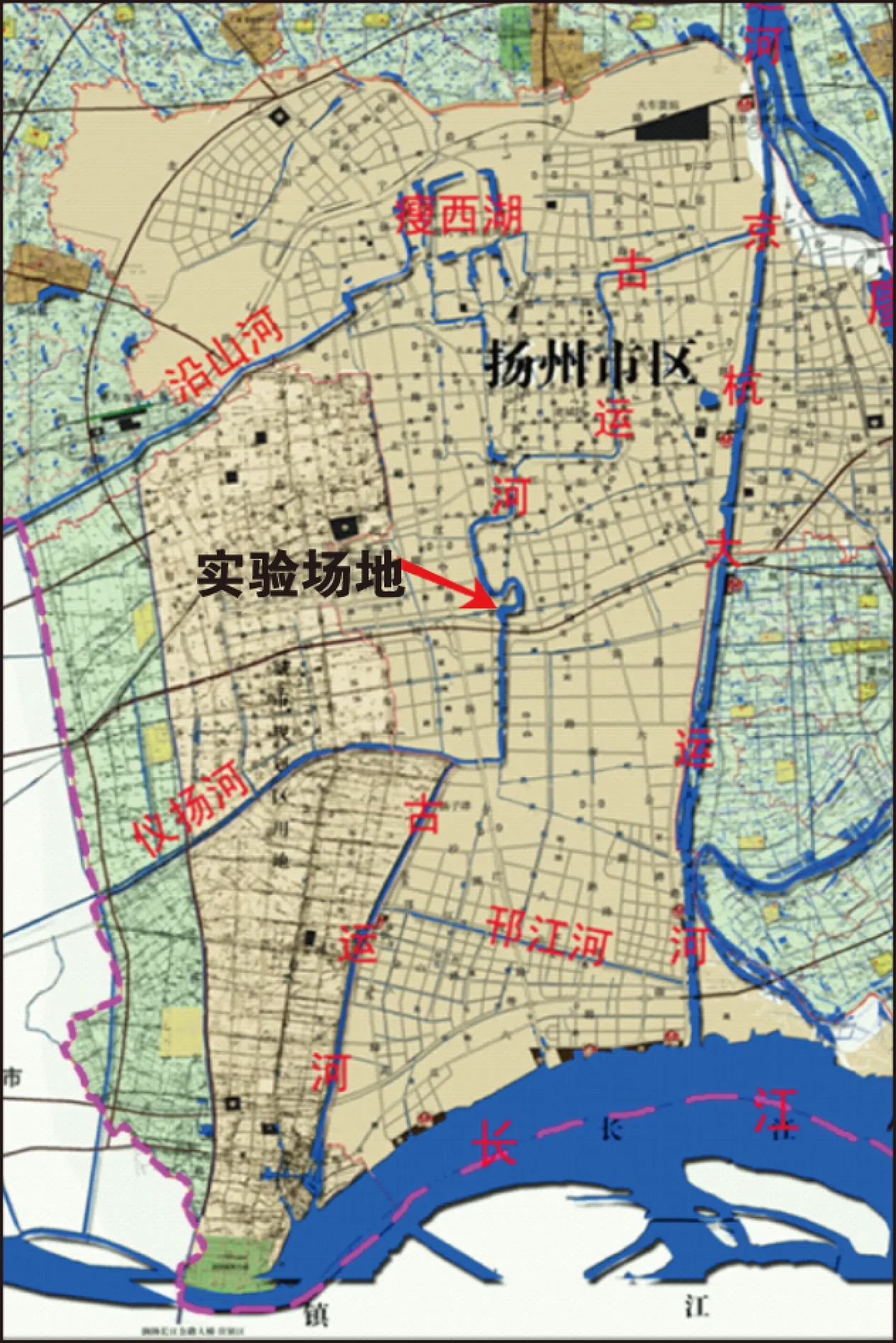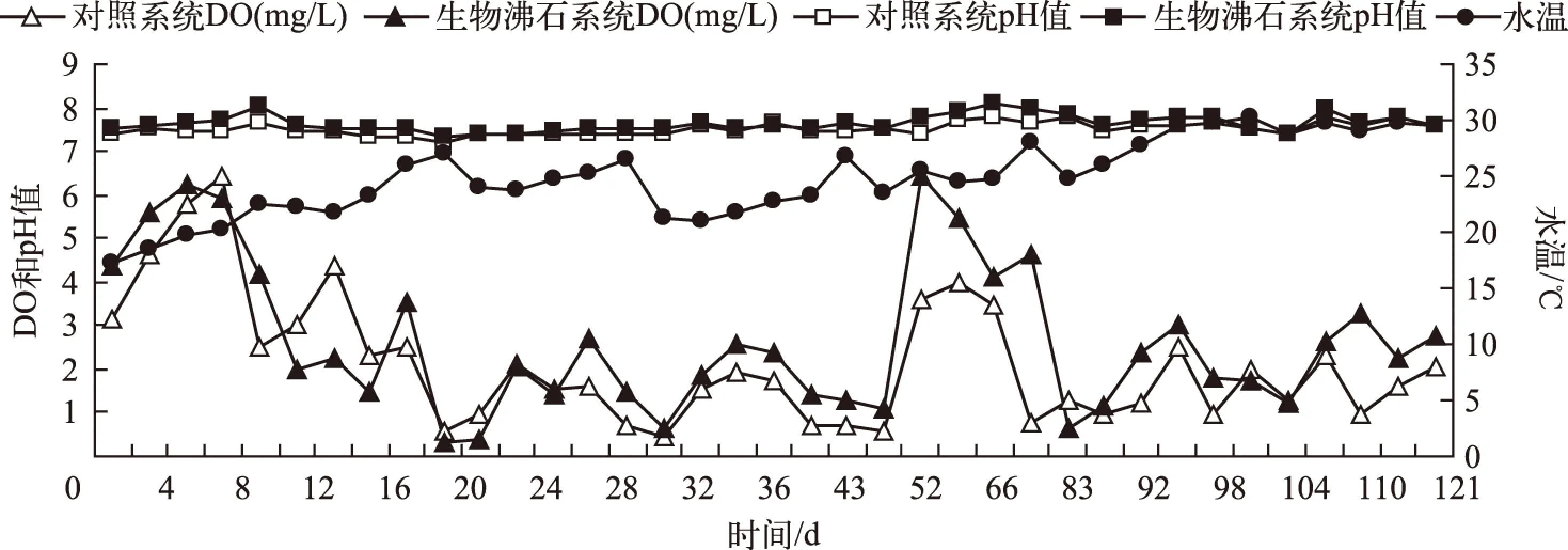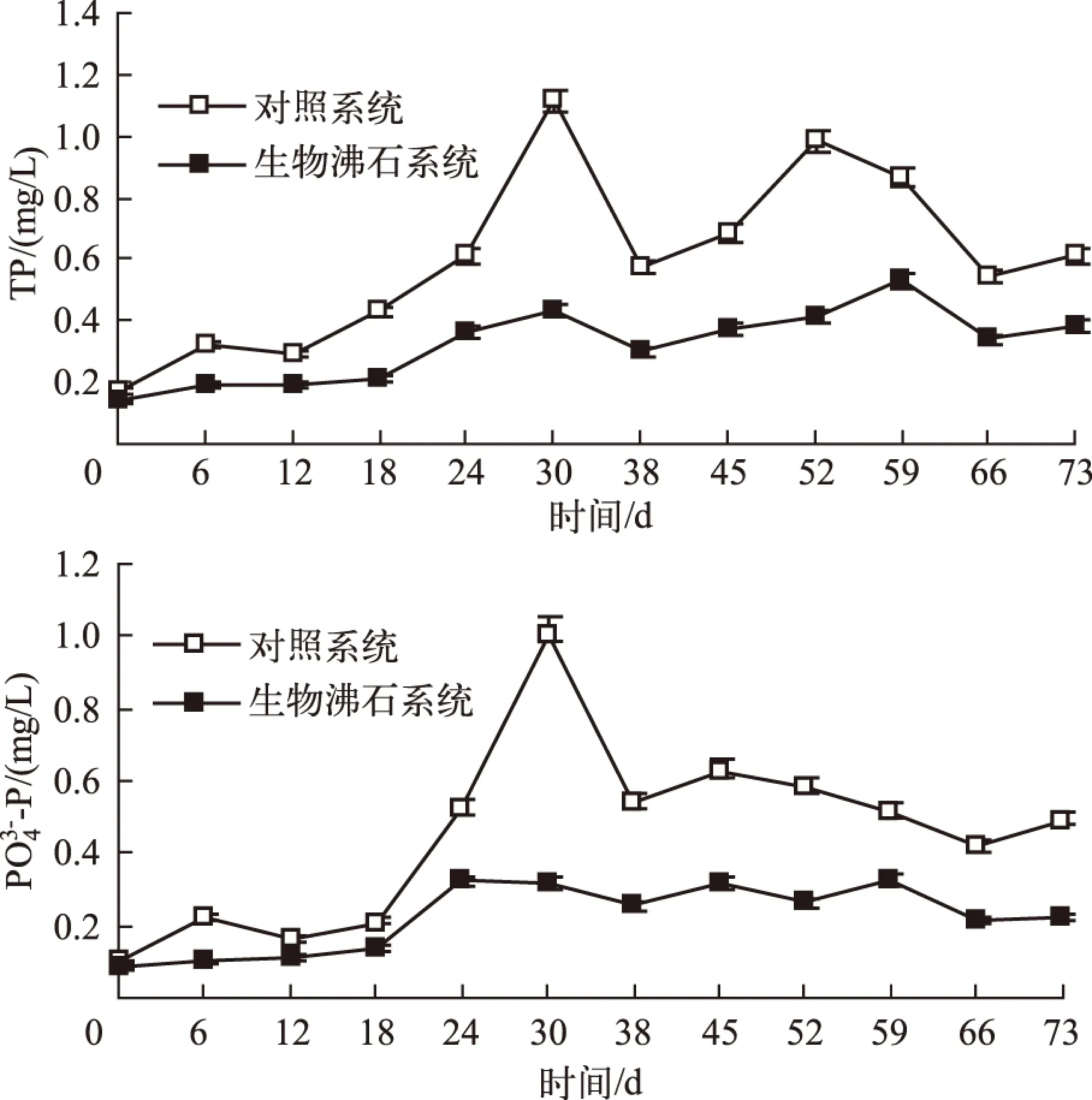生物沸石薄层覆盖削减富营养化水体磷负荷*
周真明,黄廷林,苑宝玲
(1:华侨大学土木工程学院,厦门 361021)(2:西安建筑科技大学环境与市政工程学院,西安 710055)
生物沸石薄层覆盖削减富营养化水体磷负荷*
周真明1,2,黄廷林2**,苑宝玲1
(1:华侨大学土木工程学院,厦门 361021)(2:西安建筑科技大学环境与市政工程学院,西安 710055)
以江苏扬州古运河富营养化水体为对象,现场围隔实验研究生物沸石薄层覆盖削减富营养化水体磷负荷可行性,考察生物沸石覆盖削减上覆水、底泥间隙水和底泥中不同形态磷的削减效果,讨论生物沸石覆盖修复过程中不同形态磷转化机制. 结果表明,覆盖强度为2 kg/m2的生物沸石覆盖(厚度约2 mm)对上覆水中总磷的削减率为57.41%,对上覆水中正磷酸盐的削减率为60.03%;对底泥间隙水中正磷酸盐的削减率为59.80%;对表层底泥(0~20 cm)中总磷削减率为11.28%,对无机磷削减率为11.82%,对有机磷削减率为11.11%. 生物沸石覆盖能将底泥中不稳定的无机磷(可溶性磷、铁结合态磷、铝结合态磷)或少部分较稳定的无机磷(钙结合态磷)转化为稳定的无机磷(包裹磷),说明生物沸石覆盖不仅能削减液相中磷负荷,而且能将固相中不稳定的无机磷转化为稳定的无机磷;可见,生物沸石薄层覆盖能有效削减富营养化水体磷负荷,利用生物沸石薄层覆盖削减富营养化水体磷负荷是可行的,但需要进一步研究富营养化水体底泥生物薄层覆盖修复过程中不同形态无机磷转化机制.
底泥;覆盖;磷;生物沸石;富营养化水体;扬州古运河
水体富营养化是当今世界水污染防治面临的重要难题之一. 随着我国工业化和城市化的发展,水体富营养化趋于严重. 氮和磷是水体富营养化的主要限制因子,其中磷被普遍认为是关键限制因子,控制水体氮和磷浓度能有效抑制水体富营养化[1]. 底泥是水体氮和磷的“源”和“汇”,底泥氮磷释放是水体氮磷主要来源之一[2-3],因此,削减底泥氮磷释放能有效控制水体富营养化. 底泥原位覆盖法是当今国内外学者研究热点,并在欧美、日本等国得到广泛应用[4]. 底泥覆盖材料从传统沙子[5]等发展到现今铁盐[6]、铝盐[7]、钙盐(方解石)[8]、天然沸石或改性沸石[9-11]、各种磷钝化剂(Z2G1[10]和phoslock©[12])等,这些研究大多是室内研究,且主要集中在对上覆水磷的控制效果及机制研究,对底泥和间隙水不同形态磷削减效果的现场原位实验研究鲜见报道.


图1 扬州古运河现场围隔实验场地位置Fig.1 Location of the field for enclosure experiment in Yangzhou Ancient Canal
1 材料与方法
1.1 实验场地及装置
现场围隔实验场地在古运河扬州城区三湾段(图1). 古运河扬州段是京杭大运河最古老的一段,其中古运河扬州城区段从湾头到瓜洲,全长约30 km,河宽24 m,水深3~5 m. 目前,古运河扬州市区段已经禁止通航,其功能主要是泄洪;该段大部分时间水体流动缓慢,趋于静止(除掉从京杭大运河引水到古运河期间);该段水体富营养化严重,时而出现藻类暴发,主要污染源是城市生活污水、工业、农业面源污染.
现场围隔的实验装置是塑料管,管长6 m、直径1000 mm,材料是硬聚氯乙烯(U-PVC),类型是双壁波纹管,管壁截面为双层结构,其内壁光滑平整,外壁等距排列的具有梯形中空结构的管材. 围隔施工过程是:通过吊车将塑料管垂直轻轻放入河中,开始依靠塑料管自身重力在底泥中缓慢下沉,当达到稳定时,采用吊车长臂轻压塑料管,使其稳定地插入底泥,塑料管高出河水常水位0.5 m,其余的长度切掉. 现场围隔实验参数:塑料管插入泥深2.5 m左右,管内上覆水深2.0 m左右,上覆水体积约1.57 m3;围隔实验共有2根塑料管,1#为对照系统(无覆盖);2#为生物沸石覆盖系统(生物沸石覆盖强度为2 kg/m2,覆盖厚度约为2 mm).
1.2 实验材料
实验所用的沸石为中国内蒙巴彦淖尔的天然沸石,经过X射线衍射仪(XRD)检测,其主要矿物成分为斜发沸石,伴生矿为正长石和石英. 沸石表观颜色为红褐色,粒径为1~2 mm,比表面积为42.51 m2/g,孔隙率为36.55%,平均孔径为6.75 nm,堆积密度为1.01 g/cm3,真实密度为2.29 g/cm3. 经过X射线荧光光谱仪(XRF)测定,该沸石的主要化学元素成分为:Si 73.98%;Al 8.99%;Ca 5.07%;K 4.68%;Fe 3.11%;Na 2.13%;Mg 1.51%;还含有Mn、Ti、Zn、Cu、Ni、Co、Sr、Zr、Rb等其它微量元素,合计0.53%;Si/Al=8.23.
实验所用的生物沸石制备过程如下:(1)从污染底泥中分离、筛选出高效菌,本课题组获得4株高效菌,其中2株高效异养硝化细菌(均为芽孢杆菌属,Bacillussp.)和2株高效好氧反硝化菌(均为不动杆菌属,Acinetobactersp.),4株菌的生理生化特征详见参考文献[11,13];(2)将4株高效菌液按照等体积比例混合制备混合菌液,再将混合菌液与灭菌的古运河原水按照1∶9体积比混合制备混合液;(3)将天然沸石浸置在混合液中,混合液的液面高于沸石层5 cm左右,通过连续曝气挂膜法制备生物沸石,制备过程中混合液的DO1 mg/L. 具体详细制备过程参考文献[11,13].
现场围隔实验装置完成后,实验系统中上覆水水质如表1所示. 由于进行现场围隔时,很难做到每次对底泥扰动程度相同,因此造成对照系统和生物沸石覆盖系统中水质有些差异.

表1 扬州古运河上覆水水质
1.3 实验方法


1.4 项目测试方法
1.4.1 沸石相关指标测定方法主要矿物成分采用XRD分析(德国Bruker-AXS公司,型号D8 Advance,XRD);主要元素成分采用XRF分析(美国热电公司,型号RL Thermo EDXRF Quant’s,XRF);比表面积采用多点BET法测定(贝士德仪器科技(北京)有限公司,型号3H-2000PS2,静态容量法、比表面积及孔结构测定仪);孔隙率和孔径分布采用BJH法(园筒孔模型)测定(测定仪器名称、生产厂家及型号同比表面积);真实密度采用He置换,在真空容量吸附装置中测定.

1.4.3 底泥相关项目测试方法底泥TP含量采用高氯酸-硫酸消化—钼锑抗分光光度法测定,不同形态无机磷(DP、Al-P、Fe-P、Ca-P和RP)采用连续萃取法测定[15];本文中的无机磷为不同形态无机磷之和,即IP=DP+Al-P+Fe-P+Ca-P+RP;本文有机磷为总磷与无机磷之差.
1.5 数据处理
上覆水体和底泥中不同形态磷削减率P按照公式(1)计算:
(1)
式中,CC0和CCi分别为初始和第i次取样时生物沸石覆盖系统上覆水或底泥中不同形态磷浓度(mg/L或mg/kg);CNC0和CNCi分别为初始和第i次取样时对照系统上覆水或底泥中不同形态磷浓度(mg/L或mg/kg);i为取样次数.
采用方差分析生物沸石覆盖系统与对照系统之间削减磷污染物效果的差异.
2 结果与讨论
2.1 削减上覆水体中磷负荷能力
现场围隔实验运行过程中,对照系统和生物沸石覆盖系统中水温变化范围为17.3~30.3℃,系统中水温变化较大,呈现上升趋势;水温升高,会促进底泥中磷的释放[16]. 对照系统和生物沸石覆盖系统中DO浓度变化范围为0.32~6.46 mg/L,生物覆盖系统中DO浓度整体来看高于对照系统,水体DO浓度低于2 mg/L,底泥中磷释放强度明显增加[13]. 对照系统和生物沸石覆盖系统中的pH值变化范围为7.20~8.12,对照系统与生物沸石覆盖系统中pH值变化差异不大(图2).

2.2 削减底泥间隙水中磷负荷能力


图2 各系统上覆水中水温、DO浓度和pH值的变化Fig.2 Changes of water temperature, dissolved oxygen concentration and pH of overlying water in two systems

图3 各系统上覆水中TP和-P浓度的变化Fig.3 Changes of TP and -P concentrations of overlying water in two systems

表2 各系统底泥间隙水-P浓度垂向变化
2.3 削减底泥中磷负荷能力
对照系统底泥TP、IP和OrP含量均有不同程度减少(表3),说明由于实验过程中上覆水体水温逐渐增加促进底泥向上覆水体释放磷污染物,增加上覆水磷负荷. 与对照相比,生物沸石覆盖系统对表层(0~20 cm)底泥TP削减率为7.64%~13.49%,平均值为11.28%;对IP削减率为9.24%~13.99%,平均值为11.82%;对OrP削减率为6.91%~14.81%,平均值为11.11%,说明生物沸石覆盖对底泥磷负荷有一定削减效果.
对照系统表层(0~20 cm)底泥中D-P、Al-P和Ca-P垂向含量都有不同程度减少(表3),而Fe-P、RP垂向含量有增加也有减少,但总体有增加趋势,说明扬州古运河底泥的不同形态无机磷之间转化比较复杂,需要通过进一步研究底泥不同形态无机磷转化机制. 与对照相比,生物沸石覆盖系统对表层(0~20 cm)底泥中D-P、Al-P、Fe-P和Ca-P平均削减率分别为13.7%、15%、18.2%和11.6%,而RP含量提高了1倍左右,说明生物沸石覆盖能将底泥中不稳定的无机磷(D-P、Al-P和Fe-P)转化为稳定状态的无机磷(RP),同时少部分的比较稳定的Ca-P也转化为更为稳定的RP,因此,生物沸石覆盖有利于将底泥中不稳定的无机磷(DP、AL-P、Fe-P和Ca-P)转化为稳定的无机磷(RP),有助于磷的固定.
2.4 削减磷负荷作用机理讨论
1)沸石对磷的物理吸附. 目前研究报道的沸石或改性沸石对磷吸附量大小差异性较大[13,17-20],主要因为沸石类型、初试溶液浓度、沸石投加量、沸石粒径等因素对沸石吸附量影响比较大,不同的实验条件下,得到的沸石磷吸附量不同. 初始溶液磷浓度越高,沸石对磷吸附量越大;沸石投加量越多,对溶液中磷削减效果越好,但单位质量沸石吸附磷量可能存在减少;沸石粒径越小,对磷吸附量越大,但沸石粒径太小,自身重量太轻不利于覆盖. 因此,在实际应用前,有必要在应用对象现有的条件下进行实验研究,估算出沸石对磷吸附量、找到沸石最佳投加量及最佳粒径,指导实际应用.

表3 各系统底泥中不同形态磷含量的垂向变化
3)生物沸石覆盖能将底泥中不稳定的无机磷(D-P、Fe-P和Al-P)或少部分较稳定的无机磷(Ca-P)转化为稳定的无机磷(RP). 其结论与其他研究结果趋于一致,但不同研究条件下,沸石、生物沸石、改性沸石覆盖修复过程不同形态无机磷转化机制均存在些不同[5,21-24]. Yin等[25]研究表明,铝改性硅镁土覆盖能将Pmobile(底泥可迁移磷)转化为Ca-P;Yang等[26]研究表明锆改性沸石覆盖能将BD-P(碳酸氢钠提取磷)转为NaOH-P(氢氧化钠可提取磷)和RP. 可见,污染底泥原位覆盖修复过程不同形态无机磷转化机制非常复杂,影响的因素很多,需要进一步研究.
3 结论

2)生物沸石薄层覆盖能将底泥中不稳定的无机磷(D-P、Fe-P和Al-P)或少部分较稳定的无机磷(Ca-P)转化为稳定的无机磷(RP),说明生物沸石覆盖不仅能削减液相中磷负荷,而且能将固相中不稳定的无机磷转化为稳定的无机磷.
[1]Lewis WM, Wurtsbaugh WA, Paerl HW. Rationale of control of anthropogenic nitrogen and phosphorus to reduce eutrophication of inland waters.EnvironmentalScienceandTechnology, 2011, 45:10300-10305.
[2]Nilsson P, Jansson M. Hydrodynamic control of nitrogen and phosphorus turnover in an eutrophicated estuary in the Baltic.WaterResearch, 2002, 36: 4616-4626.
[3]Pan G, Dai LC, Li Letal. Reducing the recruitment of sedimented algae and nutrient release into the overlying water using modified soil/sand flocculation-capping in eutrophic lakes.EnvironmentalScienceandTechnology, 2012, 46: 5077-5084.
[4]Förstner U, Apit SE. Sediment remediation: U. S. focus on capping and monitored natural recovery. Fourth international conference on remediation of contaminated sediment.JournalofSoilsandSediments, 2007, 7: 351-358.
[5]Kim G, Jung W. Role of sand capping in phosphorus release from sediment.JournalofCivilEngineering, 2010, 14(6): 815-821.
[6]Li Dapeng, Huang Yong, Li Xiang. Phosphorus adsorption and immobility by sediments with ferric salt addition.EnvironmetalChemistry, 2013, 32(5): 797-802(in Chinese with English abstract). [李大鹏, 黄勇, 李祥. 底泥加入铁盐对水体磷的吸收和固定. 环境化学, 2013, 32(5): 797-802.]
[7]Shin EW, Han JS. Phosphate adsorption on aluminium-impregnated mesoporous silicates: Surface structure and behaviour of adsorbents.EnvironmentalScienceandTechnology, 2004, 38: 912-917.
[8]Berg U, Neumann T, Donnert Detal. Sediment capping in eutrophic lakes-efficiency of undisturbed calcite barriers to immobilize phosphorus.AppliedGeochemistry, 2004, 19(11): 1759-1771.
[9]Lin JW, Zhan YH, Zhu ZL. Evaluation of sediment capping with active barrier system (ABS) using calcite/zeolite mixtures to simultaneously manage phosphorus and ammonium release.ScienceoftheTotalEnvironment, 2011, 409: 638-646.
[10]Huang TL, Zhou ZM, Xu JLetal. Biozeolite capping for reducing nitrogen load of the ancient in Yangzhou City.WaterScienceandTechnology, 2012, 66 (2): 336-344.
[11]Özkundakci D, Hamilton DP, Gibbs MM. Hypolimnetic phosphorus and nitrogen dynamics in a small, eutrophic lake with a seasonally anoxic hypolimnion.Hydrobiologia, 2011, 661: 5-20.
[12]Meis S, Spears BM, Maberly SCetal. Sediment amendment with phoslock in Clatto reservoir (Dundee, UK): Investigating changes in sediment elemental composition and phosphorus fractionation.JournalofEnvironmentalManagement, 2012, 93(1): 185-193.
[13]Zhou Zhenming. In situ remediation of contaminated sediment using combined biological and physicochemical technology in the urban rivers and lakes[Dissertation]. Xi′an: Xi′an University of Architecture & Technology, 2013(in Chinese with English abstract). [周真明. 城市河湖污染底泥原位生物/物化组合修复技术研究[学位论文]. 西安: 西安建筑科技大学, 2013.]
[14]State Environmental Protection Administration (SEPA) of China ed. Monitoring and analyzing methods of water and wastewater, 4th ed. Beijing: China Environmental Science Press, 2002(in Chinese). [国家环境保护总局. 水和废水监测分析方法: 第4版. 北京: 中国环境科学出版社, 2002.]
[15]Jin Xingcan, Tu Qingying eds. Eutrophication investigation specification of lakes, 2th ed. Beijing: China Environmental Science Press, 1990(in Chinese). [金相灿, 屠清瑛. 湖泊富营养化调查规范: 第2版. 北京: 中国环境科学出版社, 1990.]
[16]Ju Zewen, Wei Zhiqin, Dong Hong. Effects of aquatic vegetation rehabilitation on phosphorus in water and sediments of urban landscape waters.JLakeSci, 2015, 27(2): 234-242(in Chinese with English abstract). DOI 10.18307/2015.0206. [琚泽文, 蔚枝沁, 邓泓. 水生植被恢复对城市景观水体磷浓度及沉积物磷形态的影响. 湖泊科学, 2015, 27(2): 234-242.]
[17]Zhang Chuanguang, Zhang Naiming, Yu Xiufang. Effect of denitrification and dephosphorization of thermal modified clinoptilolite for eutrophic water.ChineseJournalofEnvironmentalEngineering, 2013, 7(5): 1665-1670(in Chinese with English abstract). [张传光, 张乃明, 于秀芳. 热改性斜发沸石对富营养化水体的脱氮除磷效果. 环境工程学报, 2013, 7(5): 1665-1670.]
[18]Duan Ning, Wu Yiyuan, Zhang Yinfeng. Adsorption kinetics and thermodynamics of diatomite/zeolite composite adsorbent nitrogen and phosphorus removal.BulletinoftheChineseCeramicSociety, 2014, 33(12): 3151-3158(in Chinese with English abstract). [段宁, 吴依远, 张银凤. 硅藻土/沸石复合颗粒吸附材料脱氮除磷的吸附动力学及热力学分析. 硅酸盐通报, 2014, 33(12): 3151-3158.]
[19]Yang Mengjuan, Lin Jianwei, Zhan Yanhuietal. Immobilization of phosphate in Taihu Lake sediment-water systems using aluminum-modified zeolites and zirconium-modified Zeolites as Amendments.ResearchofEnvironmentalSciences, 2014, 27(11): 1351-1359(in Chinese with English abstract). [杨孟娟, 林建伟, 詹艳慧等. 铝和锆改性沸石对太湖底泥-水系统中溶解性磷酸盐的固定作用. 环境科学研究, 2014, 27(11): 1351-1359.][20]Zhang Xiangling, Chen Junjie, Guo Luetal. Analysis on the removal efficiency and mechanisms of phosphorus by modified zeolites substrates coated with ldhs reacted by different metal compounds in laboratory-scale vertical-flow constructed wetlands.EnvironmentalScience, 2014, 35(12): 4553-4559(in Chinese with English abstract). [张翔凌, 陈俊杰, 郭露等. 垂直流人工湿地LDHs覆膜改性沸石基质强化除磷效果及其机制. 环境科学, 2014, 35(12): 4553-4559.]
[21]Akhurst D, Jones GB, McConchie DM. The application of sediment capping on phosphorous speciation and mobility in a sub-tropical dunal lake.MarineandFreshwaterResearch, 2004, 55: 715-725.
[22]Gibbs MM, Hickey CW, Özkundakci D. Sustainability assessment and comparison of efcacy of four P-inactivation agents for managing internal phosphorus loads in lakes: sediment incubations.Hydrobiologia, 2011, 658: 253-275.
[23]Xiong WH, Peng J. Laboratory-scale investigation of ferrihydrite-modified diatomite as a phosphorus co-precipitant.Water,AirandSoilPollution, 2011, 215: 645-654.
[24]Sun Shiquan, Jiang Changbo, Zhao Gangetal. Influencing factors of zeolite in-situ remediation system to control moderately labile organic phosphorus migration and transformation in shallow water.ChinaEnvironmentalScience, 2015, 32(2): 550-557(in Chinese with English abstract). [孙士权, 蒋昌波, 赵刚等. 沸石覆盖原位控制湖泊内源中等活性有机磷迁移转化. 中国环境科学, 2015, 32(2): 550-557.]
[25]Yin HB, Kong M. Reduction of sediment internal P-loading from eutrophic lakes using thermally modied calcium-rich attapulgite-based thin-layer cap.JournalofEnvironmentalManagement, 2015, 151: 178-185.
[26]Yang MJ, Lin JW, Zhan YHetal. Immobilization of phosphorus from water and sediment using zirconium-modified zeolites.EnvironmentalScienceandPollutionResearch, 2015, 22: 3606-3619.
Biozeolite thin-layer capping for reducing the phosphorus load in eutrophic water body
ZHOU Zhenming1,2, HUANG Tinglin2**& YUAN Baoling1
(1:CollegeofCivilEngineering,HuaqiaoUniversity,Xiamen361021,P.R.China)(2:SchoolofEnvironmentalandMunicipalEngineering,Xi’anUniversityofArchitecture&Technology,Xi’an710055,P.R.China)
The feasibility of reducing phosphorus load in eutrophic water body using biozeolite thin-layer capping was examined through a field incubation experiment in Ancient Canal in Yangzhou, Jiangsu Province, China. The reduction efficiency of different phosphorus in overlying water, interstitial water and sediments was estimated. The mechanisms of different phosphorus transportation and transformation in remediation process of sediment using biozeolite thin-layer capping were discussed. The results showed that the reduction efficiency of total phosphorus and orthophosphate in overlying water by biozeolite thin-layer capping of dose rate of 2 kg/m2(the thick of 2 mm) were 57.41% and 60.03%, respectively. The orthophosphate reduction efficiency in interstitial water from sediments was 59.80%. The reduction efficiencies of total phosphorus, inorganic phosphorus and organic phosphorus in surface sediments (0-20 cm) were 11.28%, 11.82% and 11.11%, respectively. Unsteady inorganic phosphorus (e.g. dissolved phosphorus, iron bound phosphorus, aluminium bound phosphorus) and relatively steady inorganic phosphorus (e.g. calcium bound phosphorus) were converted into very steady inorganic phosphorus (e.g. residual phosphorus) using biozeolite thin-layer capping, indicating that biozeolite thin-layer capping could not only reduce phosphorus load in liquid, but also convert unsteady inorganic phosphorus into very steady inorganic phosphorus. Therefore, biozeolite thin-layer capping can reduce phosphorus load in eutrophic water body efficiently, and phosphorus load reduction in eutrophic water body using biozeolite thin-layer capping is feasible. However, it is urgent to understand the mechanisms of different inorganic phosphorus transportation and transformation in remediation process of sediment using biozeolite thin-layer capping.
Sediment; capping; phosphorus; biozeolite; eutrophic water body; Yangzhou Ancient Canal
*国家水体污染控制与治理科技重大专项(2009ZX07317-007-1-2)、国家自然科学基金项目(51408243)、福建省自然科学基金项目(2015J01213)和华侨大学科研基金项目(14BS216)联合资助. 2015-04-15收稿;2015-10-26收修改稿. 周真明(1981~),男,博士,讲师;E-mail:zhenming@hqu.edu.cn.
**通信作者;E-mail:huangtinglin@xauat.edu.cn.

